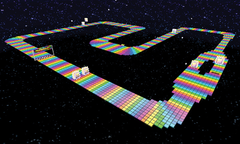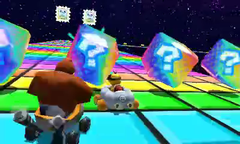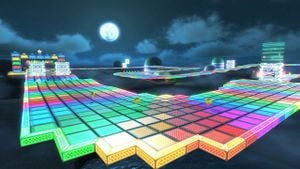SNES Rainbow Road
Template:Articleabout Template:Racecourse
The original Rainbow Road is featured in Super Mario Kart and is the final course of the Special Cup. This course is unique in the fact that it is the only track in the game that is not numbered compared to the others, and thus it is the game's only unique track. It is the shortest Rainbow Road to date, and the only track in the Special Cup with normal traction. Rainbow Road also lacks rails entirely and has only 90-degree turns. Rainbow-colored tiles and a few jumping bumps cover the track's surface, and the yellow tiles conceal Coins. This course features an unique Thwomps which can, unlike regular Thwomps, wipe out a racer by touch as well as by crushing, unless the racer activates a Star or a Boo.
Course layout
The track begins with racers taking a turn to the right, where they will find ? Panels to gather items. There are some Jumps, followed by four Thwomps. After this, racers turn to the right again where they can collect some coins, followed by another turn to the right, where there is once again a path with jumping bumps with an incoming turn that might cause racers to fall. After this turn, the track gets narrower and follows a long path where more coins and Thwomps are found along the way with another turn awaiting the player. It is here where the track gets even more narrow increasing the risk of falling. Before the final turn, the track splits into two roads; the left side contains coins while the right side has 2 ? Panels, both have a pair of Thwomps near the part where these roads merge. Alternatively, there are two jumping bumps in the middle gap; if any racers use a Mushroom while they are heading for them, they can jump over the gap for a significant shortcut. After the final turn, before the finish line, there is another quartet of Thwomps, but this time there is no space between them to pass, with players only being able to pass them by driving on the side or when the Thwomps are rising.
Appearance in Mario Kart: Super Circuit
Rainbow Road reappeared in Mario Kart: Super Circuit, as the last track of the Extra Special Cup. The background is from GBA Rainbow Road, but with only the sparkles, foreground clouds, and moon appearing. The track is transparent, but only in that game. The Thwomps and jumping bumps were removed, and the music is higher-pitched.
Appearance in Mario Kart 7
Rainbow Road returns again as the last course of the Lightning Cup in Mario Kart 7, being the first Rainbow Road to reappear as a retro track in another Mario Kart (besides its reappearance in Mario Kart: Super Circuit).
Even though this track is short, and is one of the shortest tracks in the game, there are only three laps instead of five. The course uses a similar background to that of Waluigi Pinball, another returning course in the game.
Unlike in Super Circuit, the Thwomps (now with their New Super Mario Bros. Wii appearance and referred to as "Super Thwomps") return. They are bigger (which reduces their number in the track, from sixteen to seven), and now form undulations on the track upon landing, which the player can Trick off of. Also, howling noises can be heard near the Super Thwomps.
The red tiles are now pink, and the turquoise tiles are now cyan; in first-person view, the player can see through the breaks in the tiles. The widest part of the gap in the forked road is two tiles shorter, but the gap itself is also seven tiles shorter, making the shortcut easier to use. Also, the section of tiles before the fork (from the orange tiles on the narrow part of the straight after turn 7 to the purple tiles before the gap) is wider: the first orange part, blue part, yellow part, and last purple part before the gap are now two tiles wider.
Ramps replace the yellow bumps, though the first two bumps were removed entirely, the last pair at the fork is now a single taller ramp in front of the gap, and a ramp was added on the inside of the second U-turn, adding a new shortcut (requiring a Mushroom or Mini-Turbo to get across); the ramps are only two tiles wide, rather than three, like the bumps. The finish line is also two tiles long, covering the pink tiles that used to be in front of it.
Appearance in Mario Kart 8
Rainbow Road returns for the third time in the Legend of Zelda × Mario Kart 8 DLC Pack of Mario Kart 8, appearing as the second course in the Triforce Cup. As a result, for the first time, a Rainbow Road course is not the last track in a cup. The track's layout is similar to its appearance in Mario Kart 7. The colors of the tiles are the same as they were in the original version, but this time, they have a neon appearance, their color pattern is reversed, there are now eight different colors of tiles, instead of seven from its previous appearances (adding cyan between turquoise and blue), most of the tiles now flash, and the tiles the Thwomps land on are now white. The course itself is also wider and banked (namely, the inclined third U-turn). Tiles at the edges of the track now have borders on the outer edges. The forked road is also altered further, with the narrow part of the hole's end filled in. The music is also deeper-pitched and rearranged with a slight electronic-orchestral style.
The Thwomps are the same as they were in Mario Kart 7, but they now have sparkles, a mosaic-like appearance, horizontal rainbow lines running from bottom to top of them, and use the Super Mario Galaxy Thwomp appearance, like the other Thwomps in Mario Kart 7 and Mario Kart 8, rather than their spiked New Super Mario Bros. Wii look in Mario Kart 7. Additionally, the first two Thwomps are bigger. Unlike before, when they start to crash down, they will create rainbow waves above them. Also, when they shake (preparing to crash down) and the moment they land, they make metallic glistening sounds. The waves on the track they create are now bigger, move more quickly, and disappear faster than in Mario Kart 7, making tricks more difficult to perform.
The course now takes place in a night sky with the moon visible, just like in Mario Kart: Super Circuit, but it now has color-changing hills that stick above them. Various Toad Houses litter the landscape below the course, which in itself is similar to SNES Donut Plains 3. The starting banner is now redesigned, with the traditional Super Mario Kart colored blocks with a star on top of it; the banner also stands on two walled areas, now making the start the only walled part of the course. Also, when a player approaches a turn, two green arrow holograms will appear behind the turn, and indicate in which direction the player must drive (similar to Super Circuit's new courses). Once the player has made the turn, the arrows will disappear.
Gallery
Names in other languages
Trivia
- SNES Rainbow Road has appeared in four Mario Kart games, the most times out of any track in the series.
- SNES Rainbow Road is the only course in Mario Kart 7 not to have a boost pad/ramp, and one of four courses not to have a glider pad/ramp; the others are N64 Luigi Raceway, GCN Daisy Cruiser, and Rosalina's Ice World.
- Also, in Mario Kart 8, it is one of the two only courses that does not have any boost pads, glider pads, underwater sections, or anti-gravity sections, with the other being GCN Yoshi Circuit.
- In Mario Kart 8, SNES Rainbow Road, N64 Rainbow Road, the new Rainbow Road and GCN Baby Park are the only courses in the game to have the map in different colors instead of just blue.
- Super Mario Kart composer Soyo Oka considers this course's theme one of her favorite compositions.[1]
References
- ^ Interview between Rocketbaby and Soyo Oka. Retrieved February 12, 2015.
Template:BoxTop Template:Racecourses









